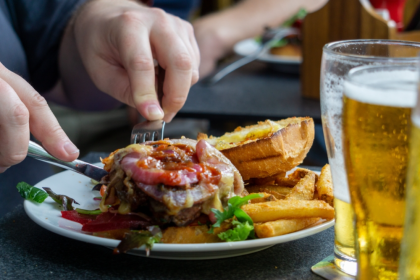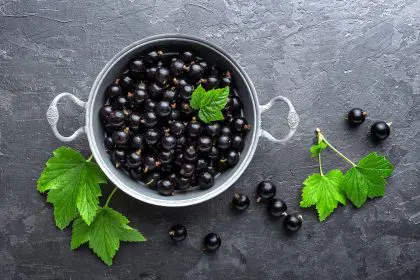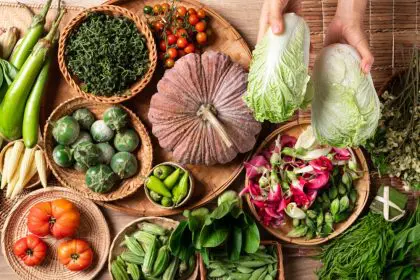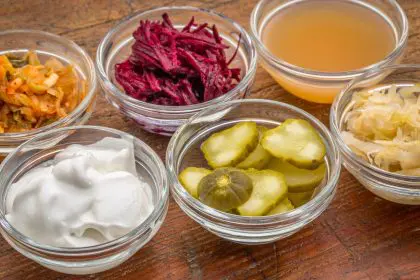That expensive organic spinach you’ve been eating might not be doing as much for your body as you think. The shocking truth is that many nutrient-rich foods fail to deliver their full benefits when eaten alone. Your body simply can’t absorb all those vitamins and minerals without a little help from their friends.
Food synergy is the hidden nutritional science that could transform your health, yet most people have never even heard of it. These powerful pairings can dramatically increase how many nutrients actually make it into your bloodstream instead of passing right through your system. Master these combinations and you’ll get substantially more nutritional bang for your grocery buck.
The iron-vitamin C connection your body craves
That spinach salad you’re eating contains plenty of iron on paper, but your body might only be absorbing a tiny fraction of it. Plant-based iron, called non-heme iron, is notoriously difficult for your body to absorb, with absorption rates sometimes as low as 2%. This explains why many people struggle with iron deficiency despite eating iron-rich foods.
The game-changer here is vitamin C, which can increase iron absorption by up to five times. This powerful vitamin transforms plant iron into a form your body can more easily use while also counteracting compounds like phytates and tannins that normally block iron absorption.
Creating this power pair is deliciously simple. Squeeze fresh lemon juice over your spinach salad or add sliced strawberries. Toss bell peppers into your bean chili. Add tomatoes to your lentil soup. Even a side of citrus fruit with your morning cereal can dramatically increase how much iron your body actually receives from that meal.
This combination works immediately during digestion, so the vitamin C and iron need to be consumed within the same meal. Planning these pairings consciously can be especially beneficial for vegans, vegetarians, and women of reproductive age, all of whom frequently struggle with iron deficiency despite seemingly adequate intake.
The fat-soluble vitamin secret
Some of the most important vitamins your body needs are fat-soluble, meaning they require dietary fat to be properly absorbed. Vitamins A, D, E, and K fall into this category, yet many people unknowingly sabotage their absorption by pairing these vitamins with fat-free foods.
That fat-free salad dressing you chose to save calories? It could be preventing you from absorbing up to 90% of the carotenoids in those colorful vegetables. These compounds, which your body converts to vitamin A, need fat to move from your digestive tract into your bloodstream.
Similarly, that vitamin D supplement you’re taking on an empty stomach might be largely wasted. Studies show that vitamin D absorption increases by 32% when taken with a meal containing fat. Even vitamin K, crucial for bone health and blood clotting, depends on dietary fat for optimal absorption.
Fortunately, you don’t need much fat to unlock these nutrients. Adding just a tablespoon of olive oil to your salad or half an avocado to your smoothie provides enough fat to significantly boost absorption. Other excellent fat sources include nuts, seeds, fatty fish, and full-fat yogurt. Incorporating these into meals containing fat-soluble vitamins ensures you’re actually benefiting from the nutrients you’re consuming.
The turmeric-black pepper breakthrough
Turmeric has exploded in popularity thanks to its potent anti-inflammatory compound called curcumin. Yet most people don’t realize that curcumin is poorly absorbed when consumed alone, with much of it passing through the digestive system without entering the bloodstream.
The solution comes from an unlikely partner. Black pepper contains piperine, a compound that can increase curcumin absorption by an astonishing 2,000%. This dramatic improvement occurs because piperine inhibits certain digestive enzymes that normally break down curcumin before it can be absorbed.
This ancient pairing, long used in traditional Indian cooking, explains why cultures using these spices together have experienced turmeric’s benefits for centuries while modern consumers taking isolated curcumin supplements often report disappointing results.
To harness this synergy, simply add freshly ground black pepper whenever you use turmeric. The combination works in everything from curries and golden milk to roasted vegetables and rice dishes. For maximum benefit, include some healthy fat as well, since curcumin is also fat-soluble, creating a triple-action absorption strategy.
The protein-zinc partnership
Zinc plays a crucial role in immune function, wound healing, DNA synthesis, and growth, yet approximately two billion people worldwide suffer from zinc deficiency. One major reason is that zinc-rich plant foods like whole grains, nuts, and legumes also contain phytates, compounds that bind to zinc and prevent its absorption.
Animal proteins contain a factor that counteracts these phytates and significantly enhances zinc absorption. This explains why vegetarians and vegans sometimes struggle with zinc status despite consuming adequate amounts on paper. Their plant-based zinc sources lack the protein partners that maximize absorption.
Creating effective combinations isn’t difficult. Pair nuts or seeds with a small amount of animal protein like cheese or yogurt. Add beans to dishes containing meat, fish, or poultry. Even moderate amounts of animal protein can substantially improve zinc availability from plant sources.
For those following plant-based diets, certain food preparation methods can help break down phytates and improve zinc absorption. Soaking nuts and legumes, fermenting grains, and sprouting seeds all reduce phytate content. Combining these preparation methods with high-protein plant foods like tempeh or seitan creates entirely plant-based meals with improved zinc bioavailability.
The calcium absorption enhancers
Calcium stands as one of the most important minerals for bone health, yet many people consuming adequate amounts still develop deficiencies over time due to poor absorption. Several factors can dramatically influence how much calcium your body actually extracts from your food.
Vitamin D serves as calcium’s crucial partner, increasing absorption in the intestines by up to 80%. Without sufficient vitamin D, even high calcium intake may not prevent bone loss. This explains why sunlight exposure or vitamin D supplementation often proves more effective for bone health than calcium alone.
Magnesium also plays an essential role in calcium metabolism, helping transport calcium ions across cell membranes. When magnesium levels are low, calcium absorption suffers. Foods rich in both minerals, like almonds, dark leafy greens, and seeds, provide a natural absorption advantage.
Conversely, some compounds actively interfere with calcium absorption. Oxalates found in spinach, rhubarb, and beet greens bind to calcium and prevent absorption. Phytates in unfermented whole grains can have similar effects. This doesn’t mean avoiding these nutritious foods, but it does suggest balancing them with lower-oxalate calcium sources like kale, bok choy, and broccoli.
Creating synergy throughout your day
Armed with these nutritional partnerships, you can strategically plan meals that maximize nutrient absorption. Start your day with vitamin C-rich fruit alongside iron-fortified breakfast cereal. Include healthy fats with your leafy green salad at lunch. Add black pepper to your turmeric-seasoned dinner vegetables.
The beauty of food synergy is that many traditional cuisines intuitively incorporate these pairings. Mediterranean diets naturally combine olive oil with vegetables rich in fat-soluble vitamins. Indian curries pair turmeric with black pepper. Mexican cuisine combines beans with vitamin C-rich tomatoes and peppers.
By understanding these powerful interactions, you can make informed choices that dramatically increase the nutritional value of everything you eat. The result isn’t just better nutrition on paper, but better actual nourishment for your body, with more vitamins and minerals making their way into your cells where they can truly support your health.
The next time you plan a meal, remember that what you eat together can be just as important as what you eat. These strategic combinations allow you to extract maximum nutrition from every bite, transforming ordinary meals into extraordinary nourishment through the hidden power of food synergy.
















